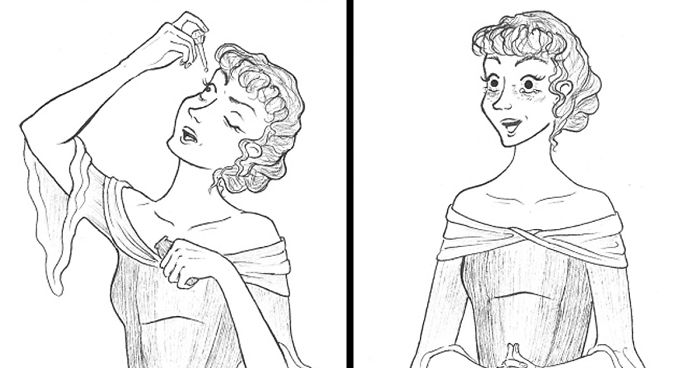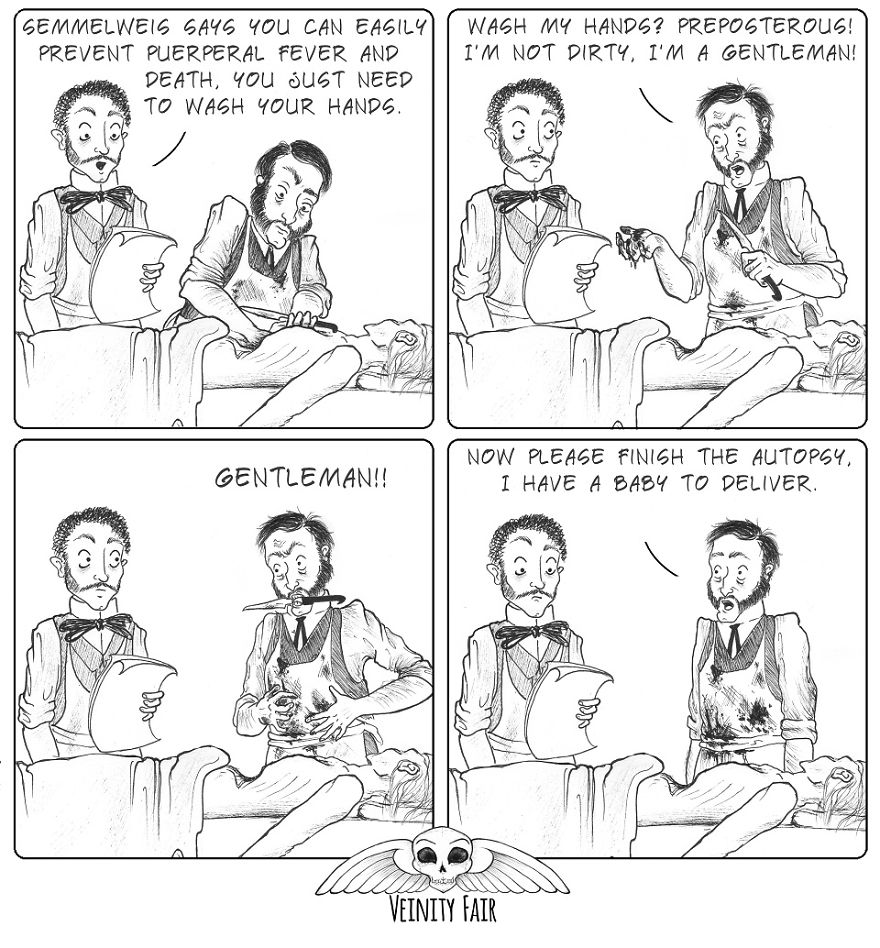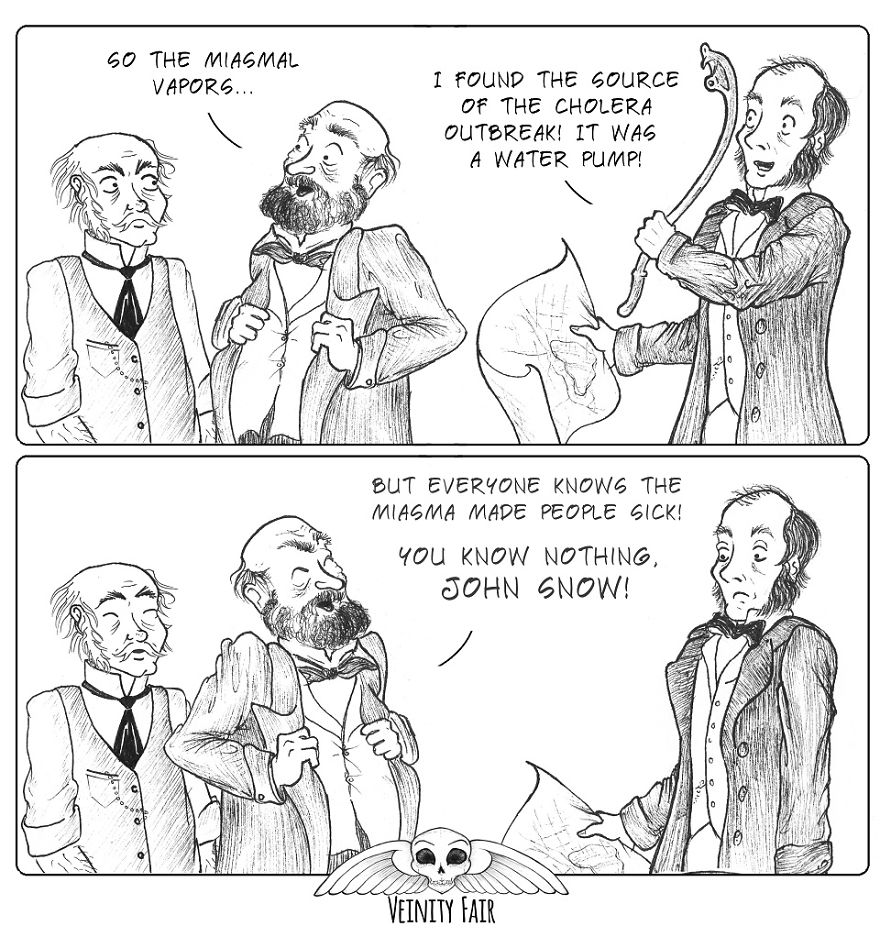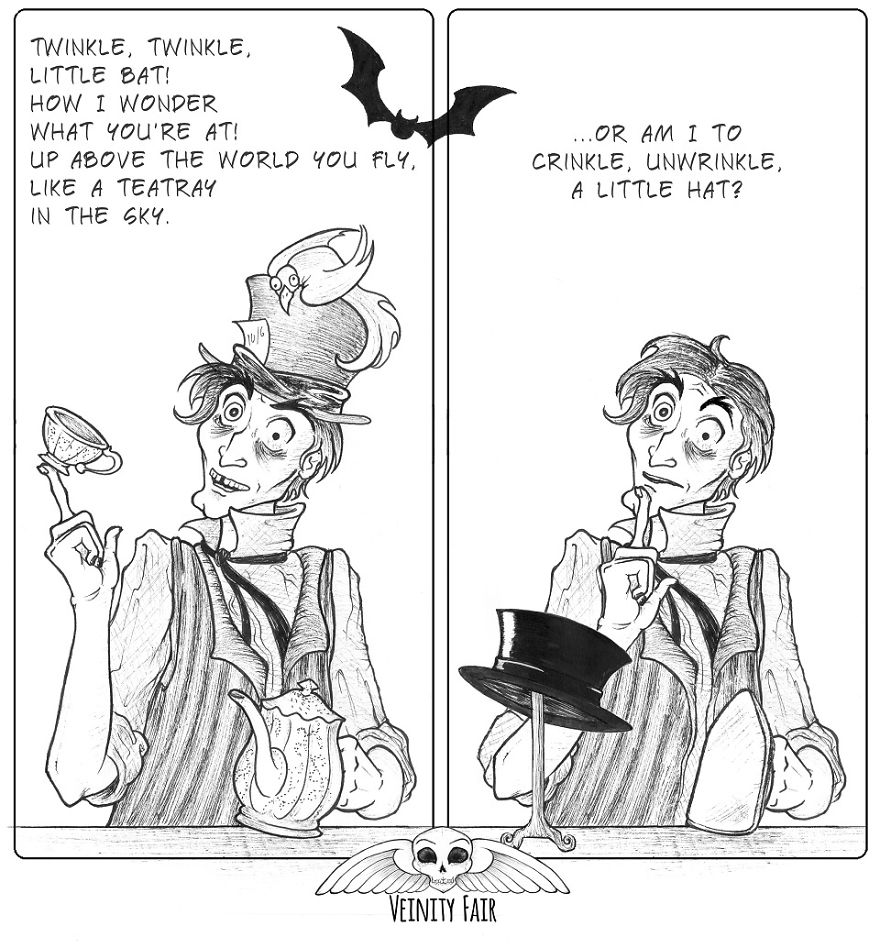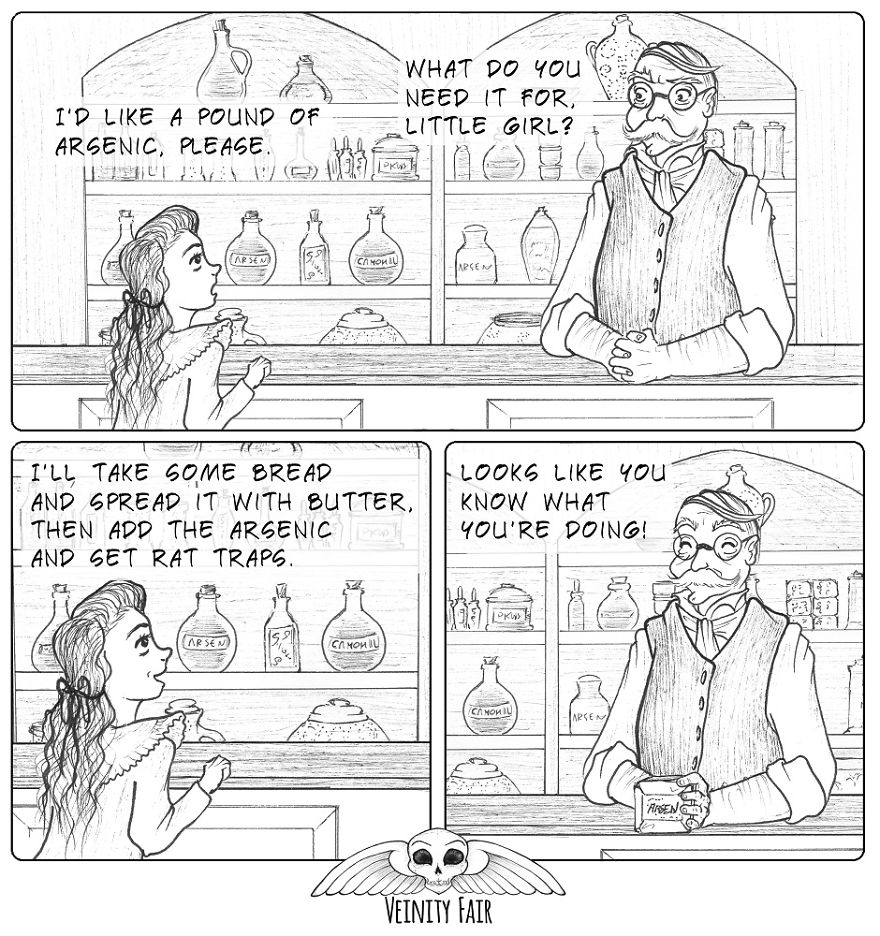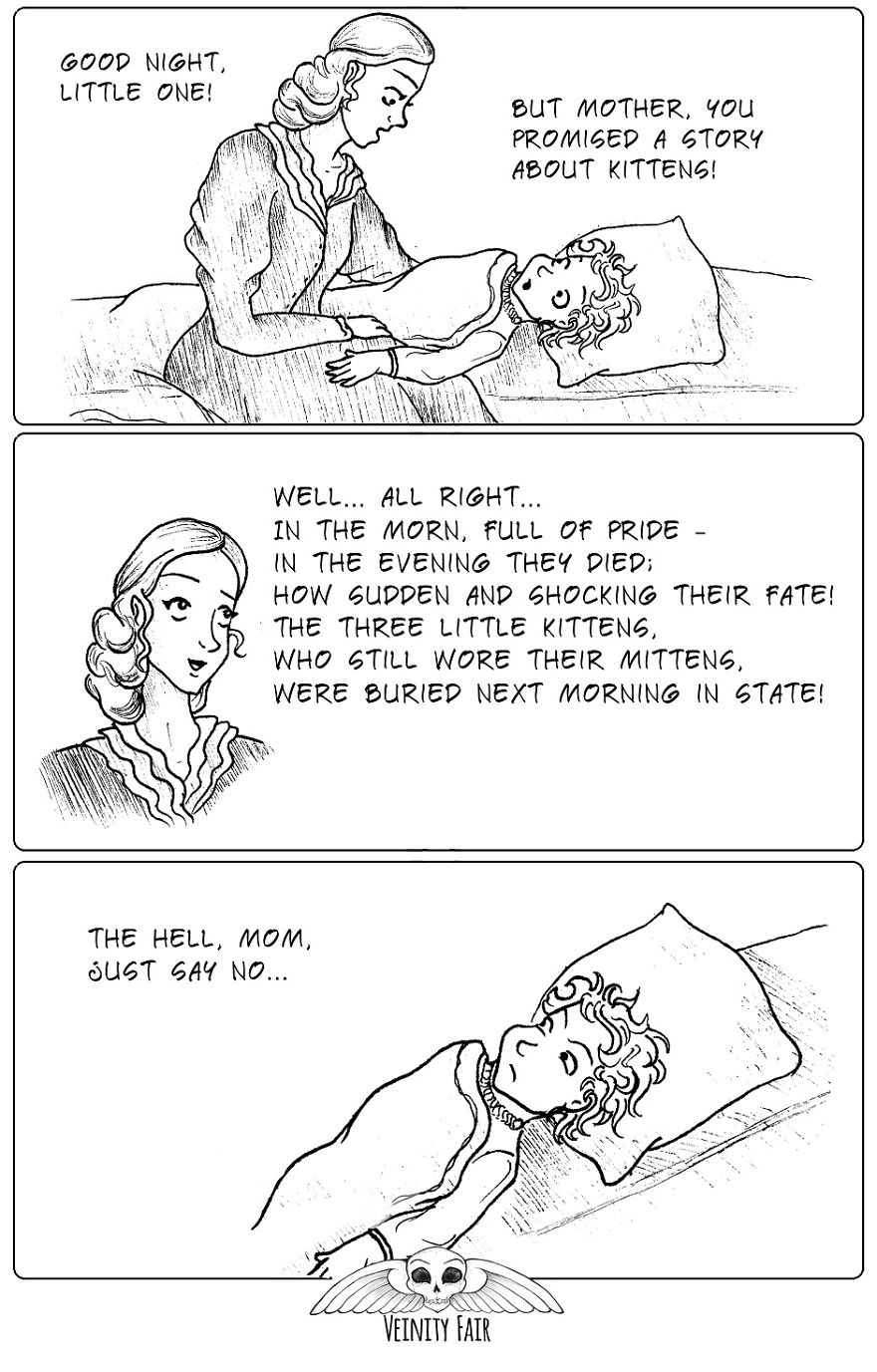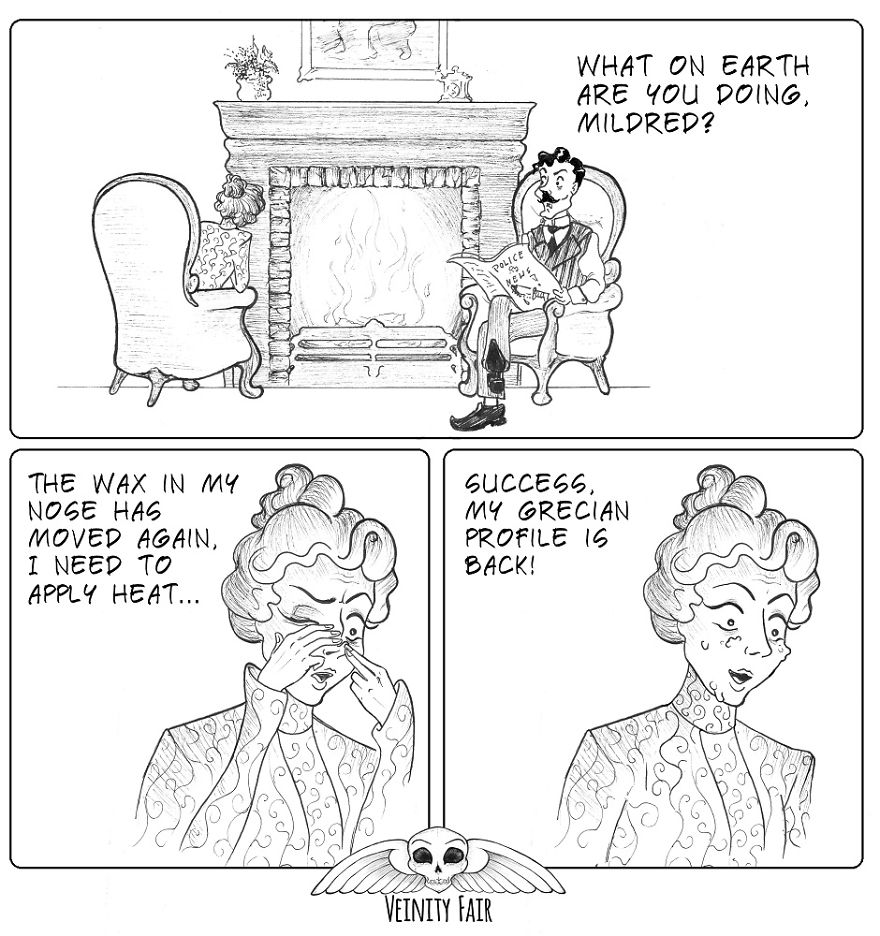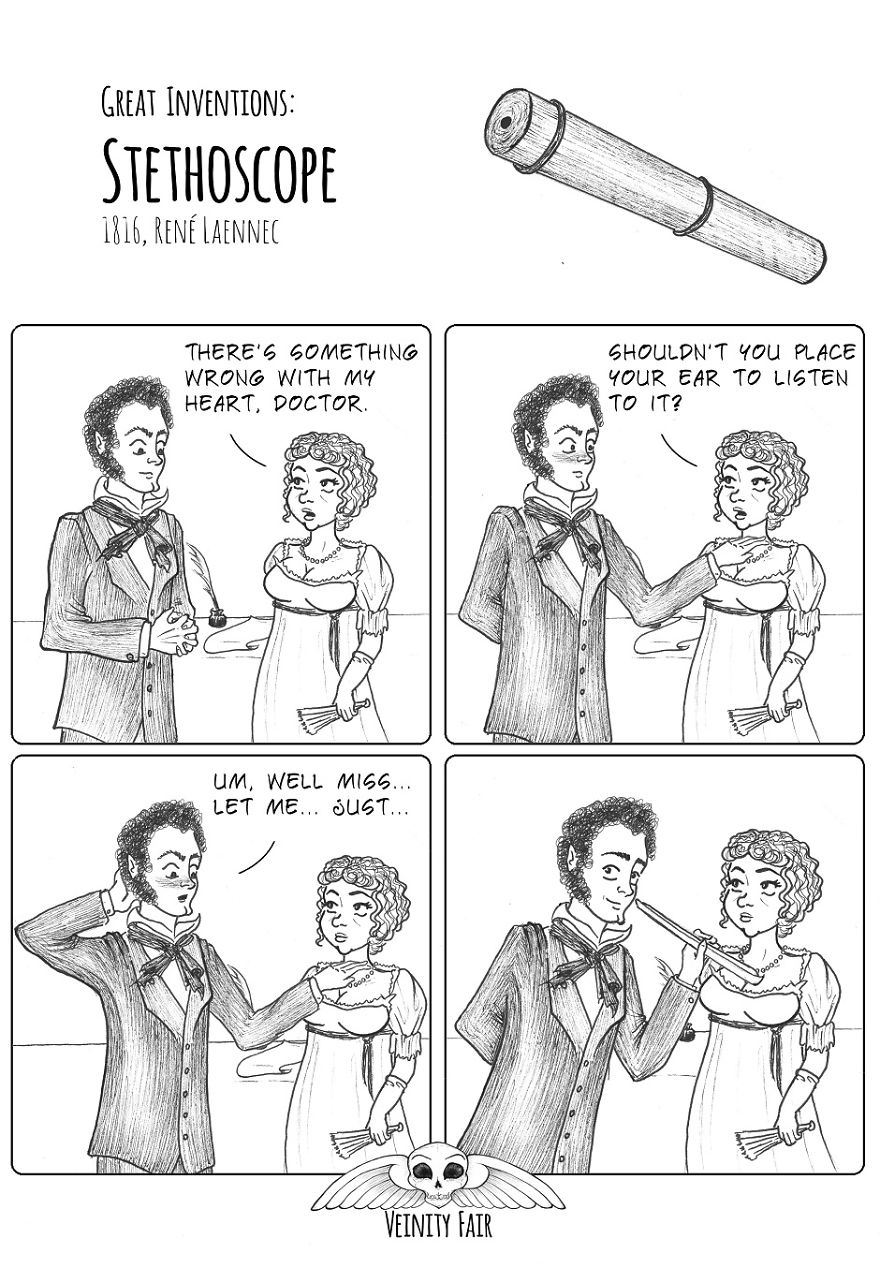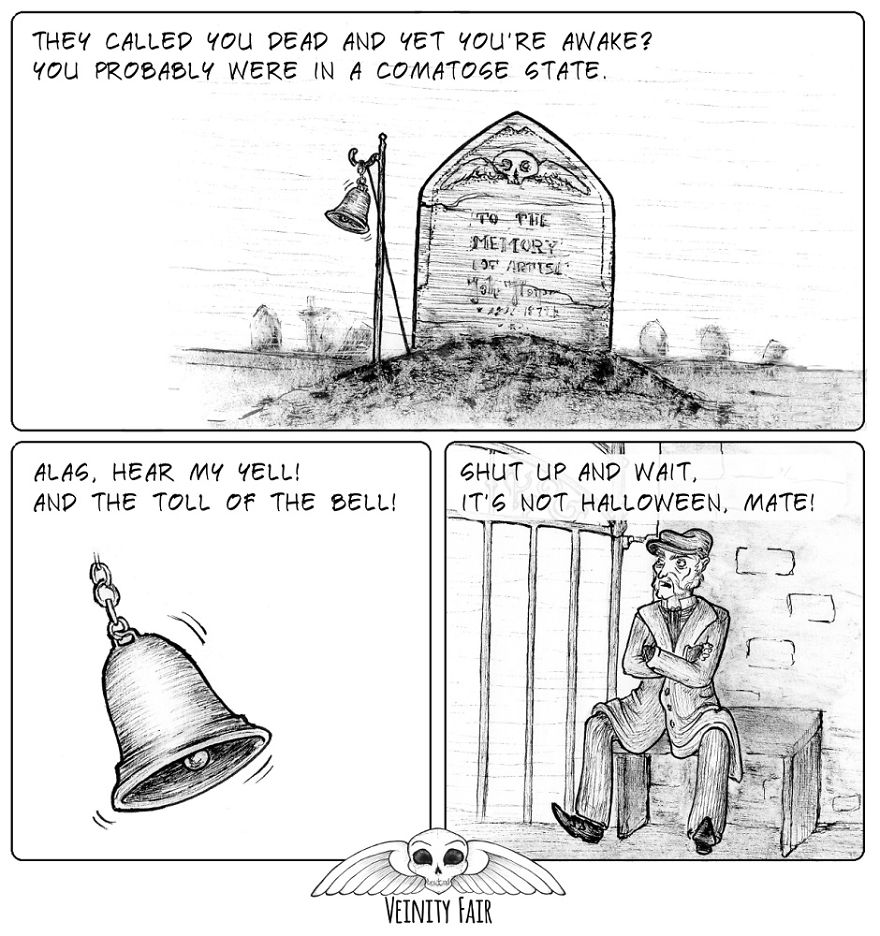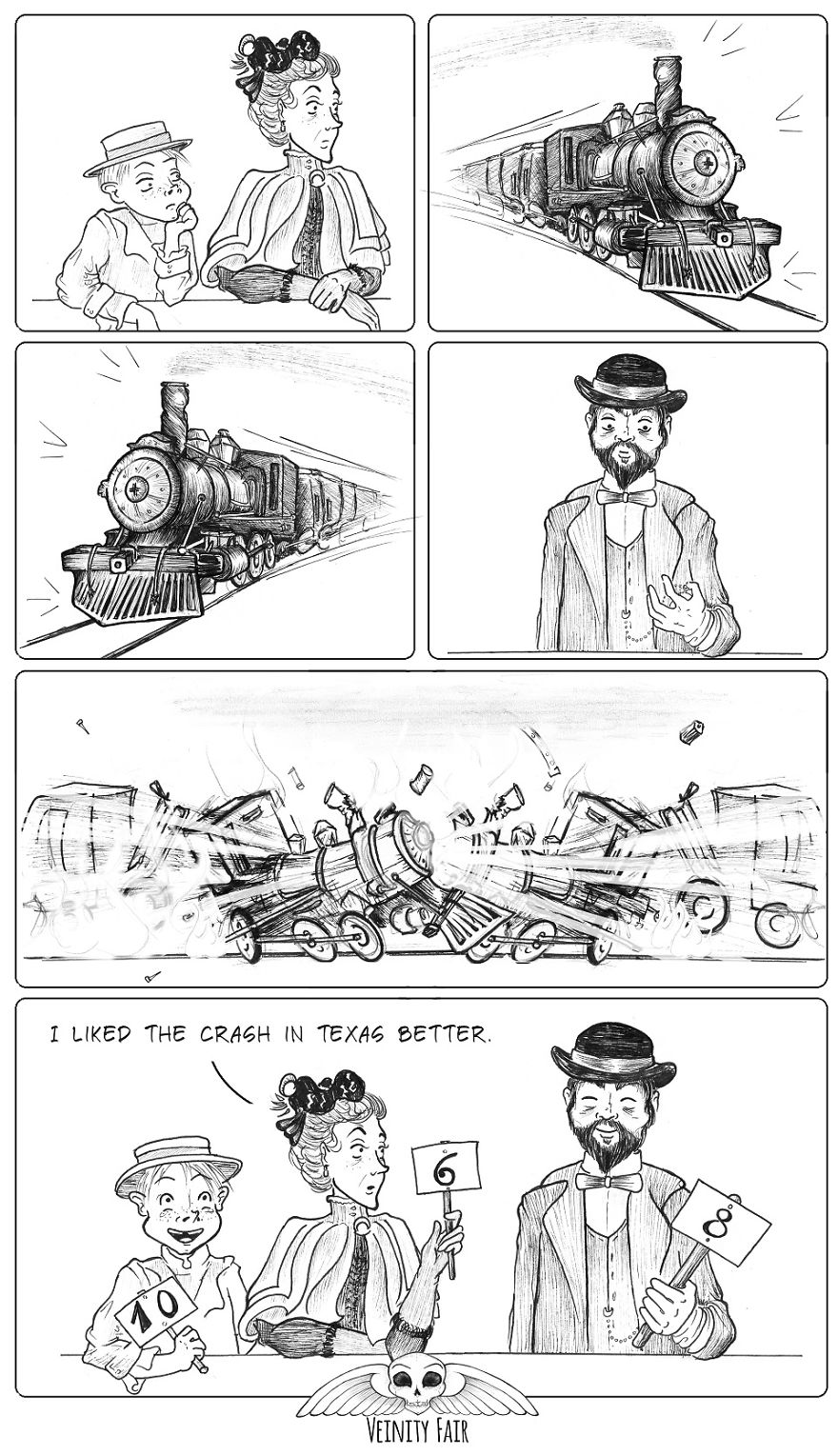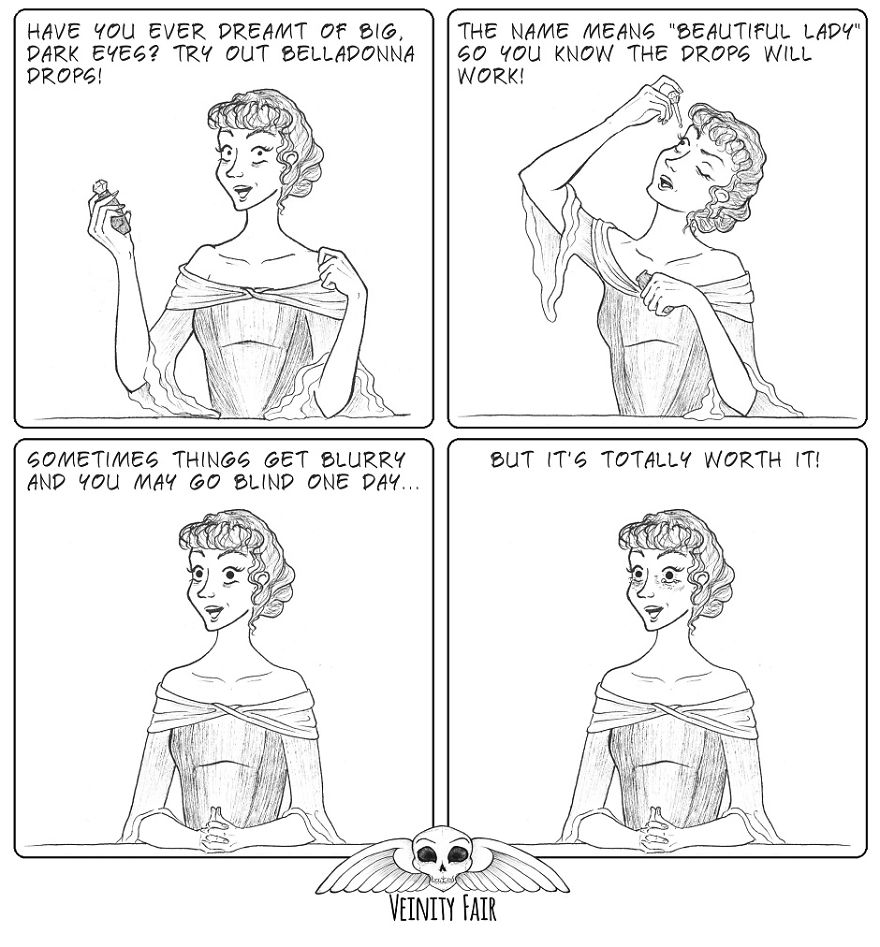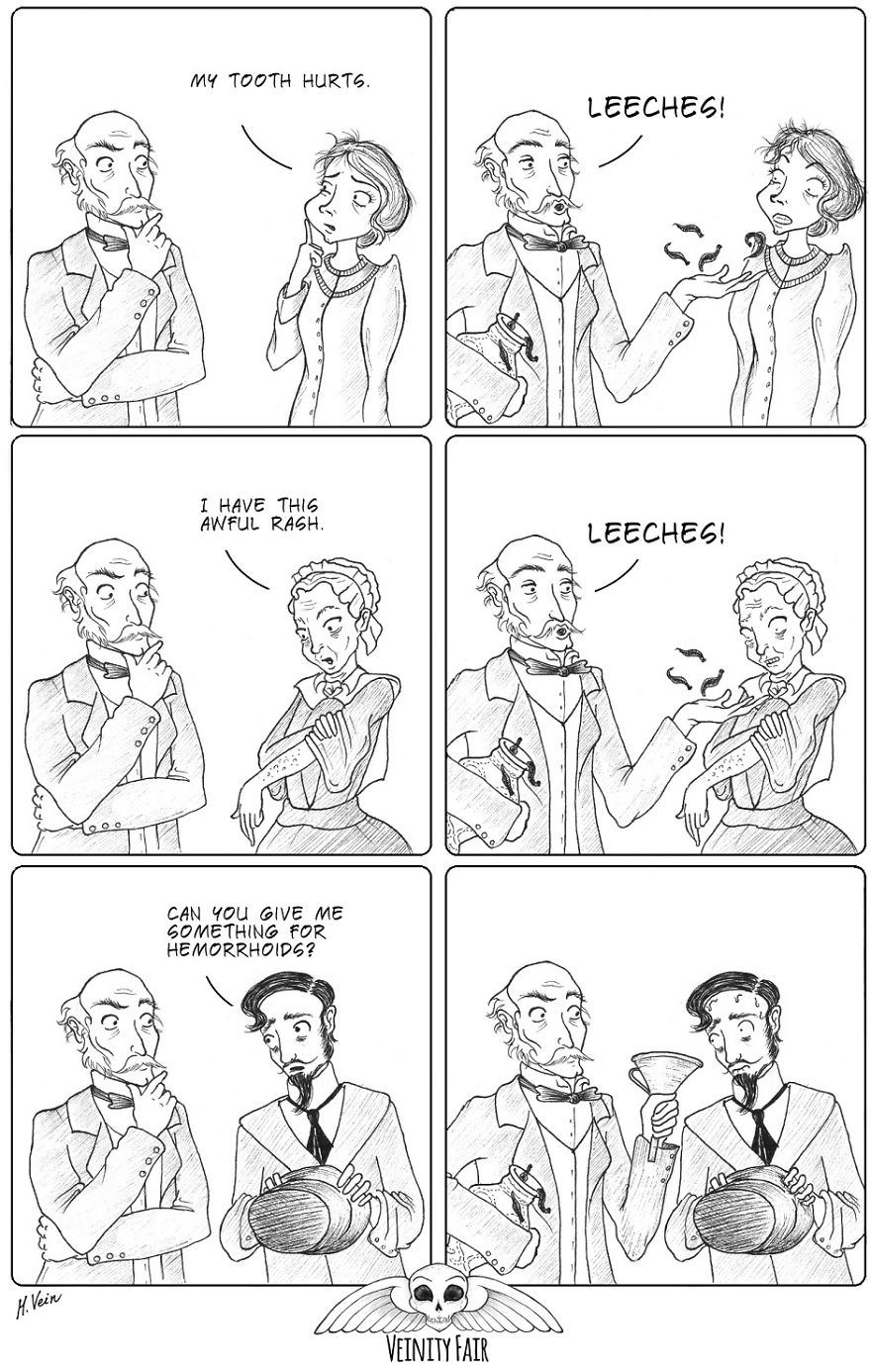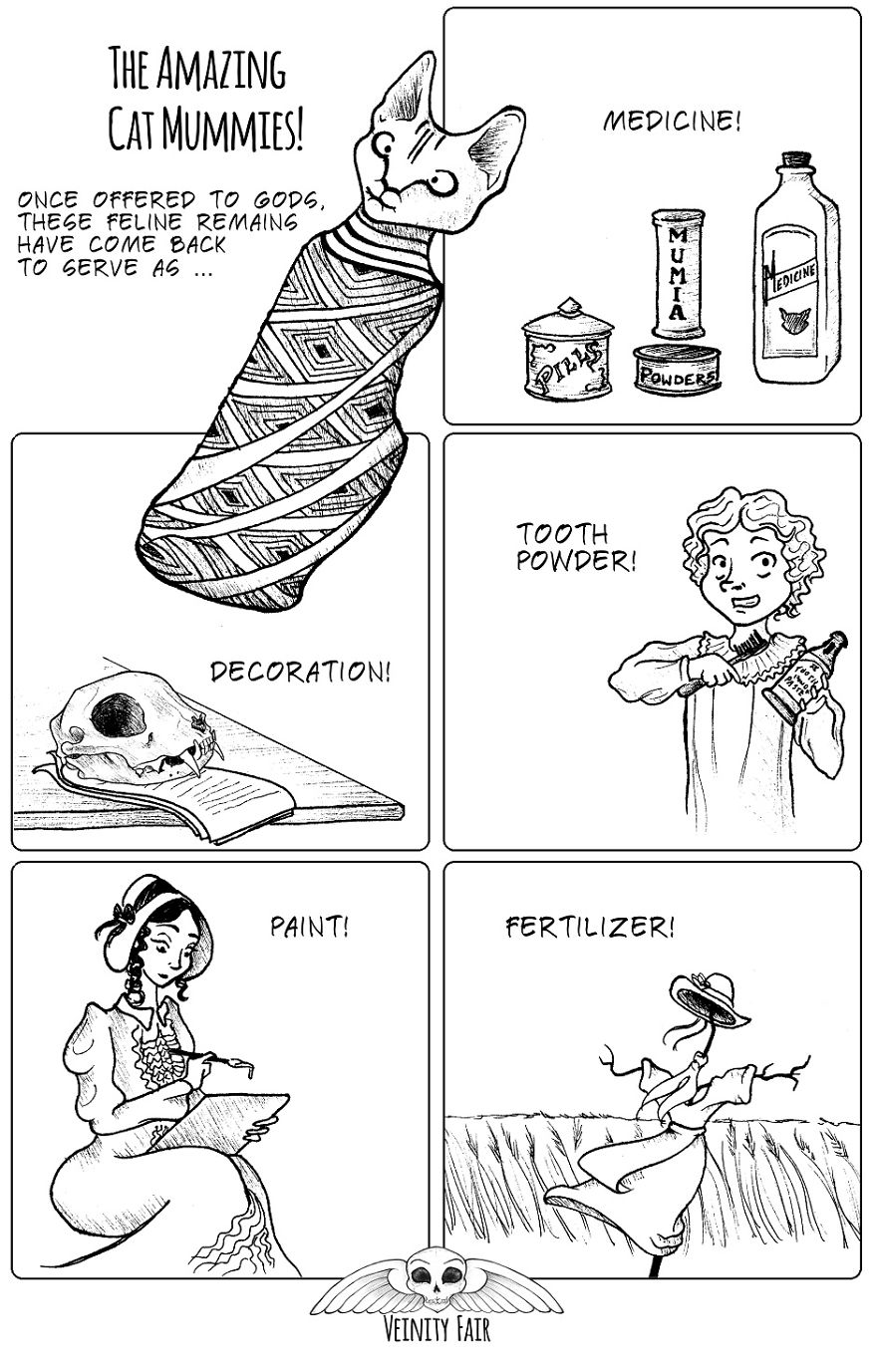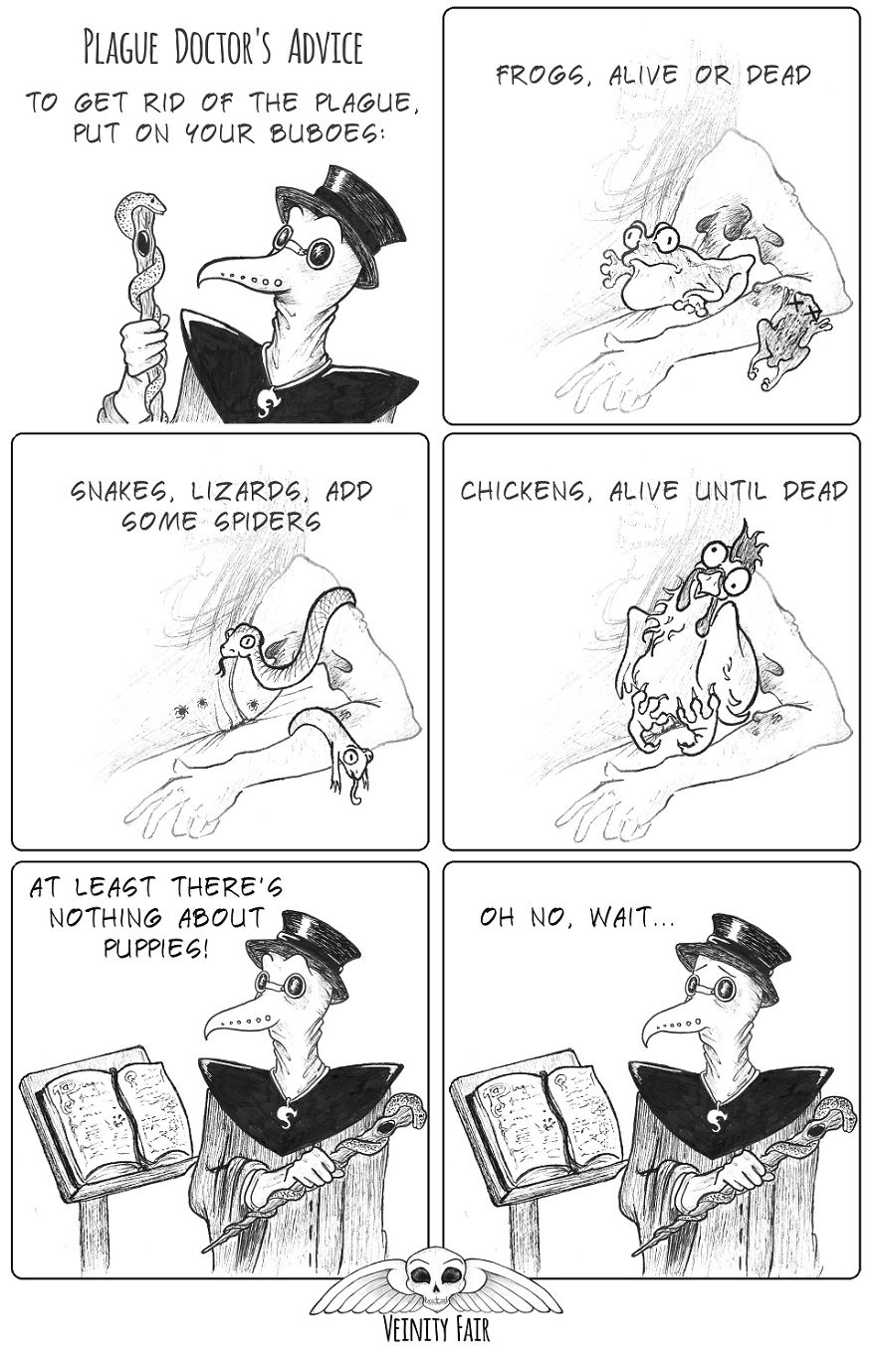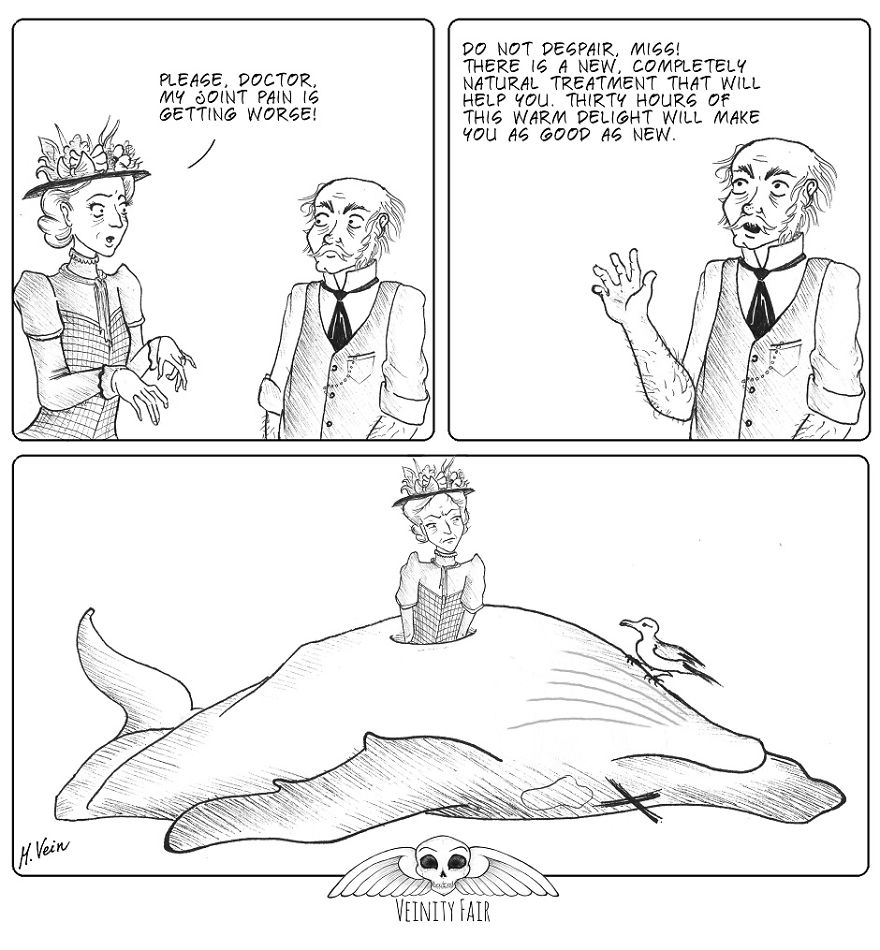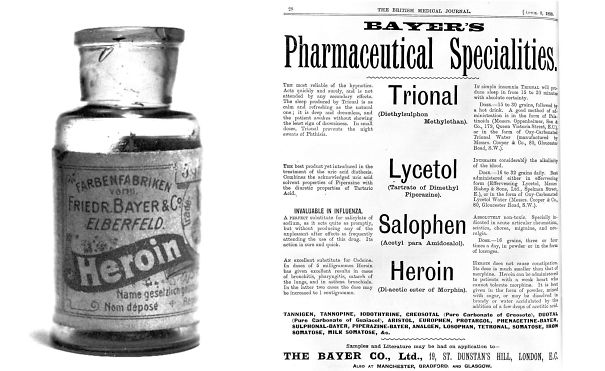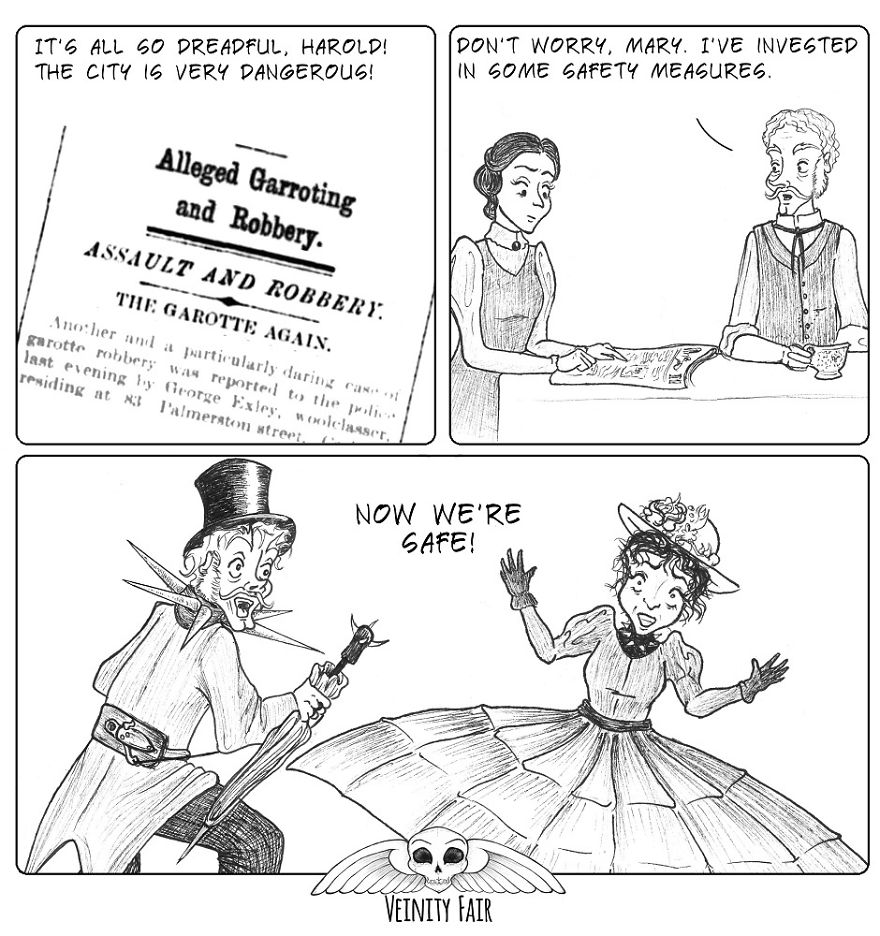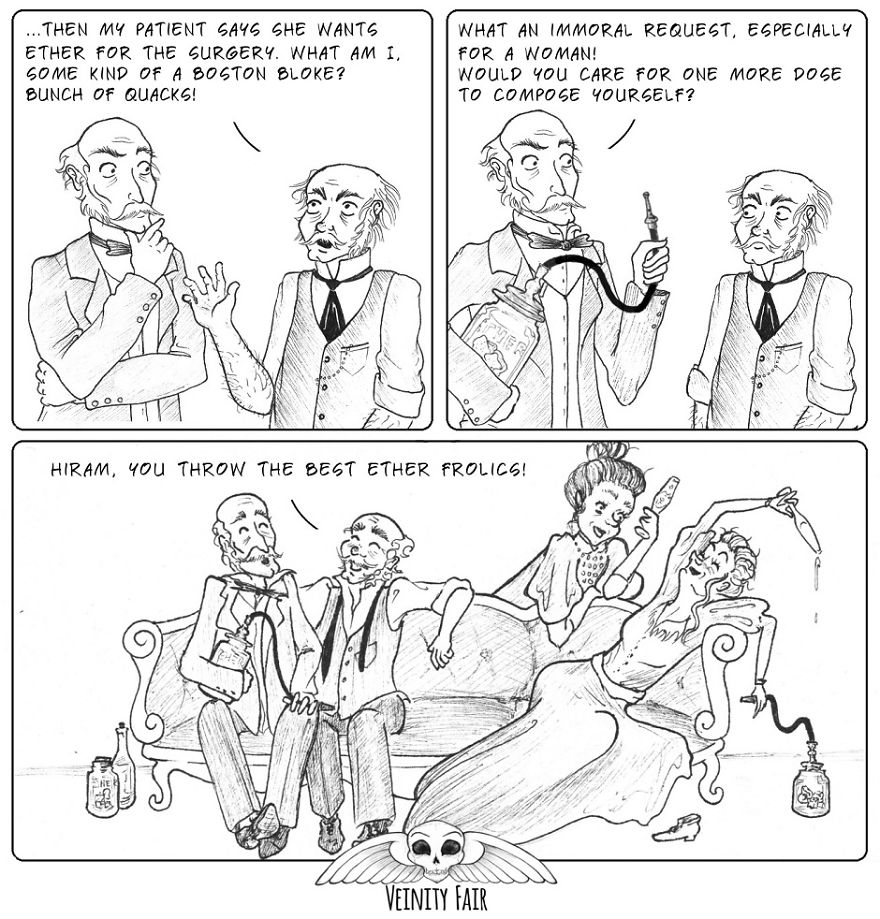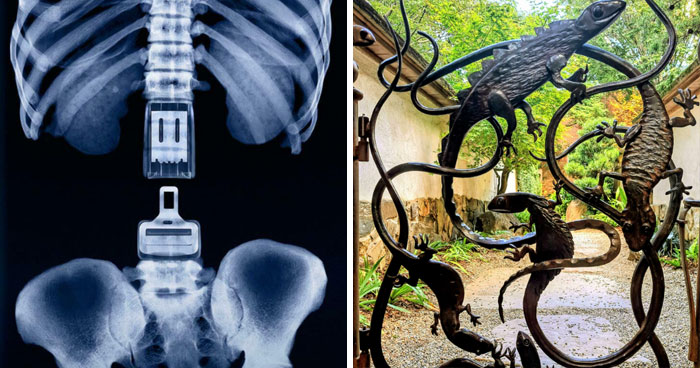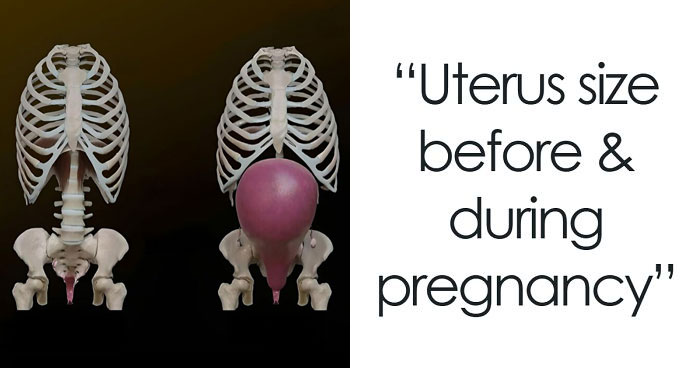When I was young, history classes were usually focused on presenting the past as a collection of important events–battles, conquests, treaties, discoveries, and inventions. While it was all interesting, I've always felt something was missing. What did the everyday life of sailors look like? How did people deal with ailments before anesthesia? What would women do during their periods? Were children having as much fun as they do today? What were the burial practices of our ancestors?
This thirst for knowledge has never ceased and I became an adult engrossed in books, documentaries, and other media which showed me the less glorious, but much more intriguing historical facts. I was especially fascinated with Victorian-era history–its perfect blend of scientific progress, bizarre practices, and questionable individuals.
Of course, I wanted to share all this knowledge with others, but it quickly turned out that not everyone is up to discussing bloodletting methods and vintage underwear during the office lunch break. And that is why I've created Veinity Fair, webcomics with unusual trivia and a dash of a dark sense of humor, fueled by morbid curiosity!
If you want to learn more about the stories presented in the funny comics or resources, check out the Veinity Fair social media and website!
More info: Facebook | Instagram | twitter.com | veinityfair.com
This post may include affiliate links.
Semmelweis' Advice
While working in Vienna General Hospital in the 1840s, Ignaz Semmelweis noticed a curious thing – the mortality rate of new mothers was a lot higher in wards supervised by doctors compared to those supervised by midwives. After some investigating, he found the source of the problem – only doctors had access to both maternity wards and autopsy tables. Semmelweis quickly developed a theory of what he called "cadaverous particles" and introduced rigorous handwashing in his clinics. Unfortunately, even though his method worked spectacularly well, he was ridiculed by most of the medical professionals until his death in a lunatic asylum.
I'm so happy to have found this 'comic'! Ignaz Semmelweis is one of my personal heroes. Thank you Marzena. : )
He's a hero in our house too! My husband just bought one of these: https://www.redbubble.com/i/mask/Science-and-Medicine-Ignaz-Semmelweis-Fan-Club-white-text-by-Ofeefee/46504416.9G0D8
Load More Replies...There's a great novel about this topic, The Bone Garden by Tess Gerritsen: https://www.goodreads.com/book/show/1430213.The_Bone_Garden It takes place partially in modern times: a woman discovers a hundred-year-old skeleton in the back yard of the house she's just moved to (while gardening) and decides to find out who it was, and partially during Victorian times, following several characters, some of them doctors... it's really well-told and fascinating!
I read this book too! That’s exactly what I thought of when I saw the comic.
Load More Replies...He wasn't the only one who thought this. Oliver Wendell Holmes' medical writings were considered innovative for their time notably his 1843 essay regarding the contagiousness of puerperal fever. https://en.wikipedia.org/wiki/Oliver_Wendell_Holmes_Sr. Also, Joseph Lister - for whom Listerine is named after - was a British surgeon who invented antiseptic surgery (albeit after Semmelweis). https://en.wikipedia.org/wiki/Joseph_Lister. It's a shame that Semmelweis wasn't listened to. Who knows how many lives could have been saved?
He was actually beaten to death (by the attendants!) in the asylum not long after arriving. That poor man was NOT honored in his own time :(
FACTS matter! "By 1865, after suffering a mental breakdown, Semmelweis was admitted to an asylum. He died of sepsis shortly thereafter at age 47, after a wound on his hand became infected" This may. or may not, have been inflicted during the struggle, or it was "the result of an operation he had performed before being taken ill". https://www.britannica.com/biography/Ignaz-Semmelweis. Wikipedia, though I love it, is not foolproof. What is clear is that he was not "beaten to death".
Load More Replies...I've always been fascinated with that particular era, as well. There were some pretty bizarre practices and beliefs, for sure! Poor Semmelweis.
John Snow
John Snow was an English physician, best known for finding the source of a cholera outbreak in Soho, 1854. By putting all known cholera cases on a map, he found the source of all troubles – a contaminated water pump. Why was it such a big deal? This discovery not only led to shutting down the pump, but also worked in favor of the budding germ theory of disease. Even though Snow himself didn't know that at the time, he contributed to the birth of epidemiology.
Maybe it was good that Snow never learned the significance of his discoveries. He would have been so discouraged to know that, in 2020, a large number of people would ignore epidemiologists, and, instead, drink bleach on the advice of a senile politician.
It's a replica. I visited it last year. It's pretty cool to see :)
Load More Replies...This is THE real Sherlock Holmes story: John Snow and Reverend Whitehead.
Ha! Who else thought that "you know nothing Jon Snow" originated from Game of Thrones!? There's more to the story than the explanation above, though. British doctor John Snow couldn’t convince other doctors and scientists that cholera, a deadly disease, was spread when people drank contaminated water until a mother washed her baby’s diaper in a town well in 1854 and touched off an epidemic that killed 616 people. https://www.ph.ucla.edu/epi/snow/snowcricketarticle.html
I assume she just didn't have the space in the strip for the WHOLE story 😅😂
Load More Replies...And he could tell it was from the pump because there were exactly zero cases in the local brewery, where everyone drank alcohol instead of water.
Did you also watched this on "Victoria"? It was a great episode. And a great show ofc. :D
Load More Replies...Also miasma, bad air or, more accurately, foul odour, is connected with bacterial infestation
Only in a secondary way. Bad smells can indicate a source of infection, but the infection doesn't literally travel through the odour. It's not like you catch a whiff then get sick, which is what the belief was at the time.
Load More Replies...A little more detail, still light, and illustrated: https://www.ph.ucla.edu/epi/snow/snowcricketarticle.html
Crinoline
Crinolines were hugely popular in the second half of the 19th century, since their fairly light construction allowed women to play with fashion and big dress shapes without the need to carry the weight of several petticoats (as it was done earlier). This vast popularity of crinolines among women of all classes led to coining the word 'crinolinemania' and numerous caricatures in the media.
And while there were some hazards connected with wearing crinolines, especially in factories or near an open fire, they were definitely great at providing some personal space.
Who else thinks that this would work for personal space problems even in the present day?
This could be great for the social distancing during quarantine. :D
with this, you could easily social distance, it just needs a 12+ diameter.
Too bad we aren't wearing them today. 6 ft distancing would be no problem at all! lol
I've always wanted a Poddle Skirt. Now I want a Grand Crinoline Skirt!
Mercury & Mad Hatter
Erethism, more commonly known as mad hatter disease, is caused by mercury poisoning and can cause a variety of symptoms including tremors, timidness, anxiety, and even hallucinations. It was quite common among hat-makers as they were exposed to mercury used in the manufacturing of felt hats.
Even though the Hatter from Alice's Adventures in Wonderland doesn't display all of these symptoms, his creation might have been inspired by erethism. We know that Lewis Carroll's uncle, Robert Wilfred Skeffington Lutwidge, was a Lunacy Commissioner supervising Pauper Lunatic Asylums. To keep patients busy, these asylums often organized group activities such as...tea parties.
Very cool! Although the cause of 'mad hatter disease' is known to be mercury, I wasn't aware of the 'tea parties' in asylums!
I had never heard of death clocks before your post. Thanks! I saw a few interesting documentaries about them!!
Load More Replies...This shows a level of compassion much higher than I would expect in a ‘children’s’ story.
Arsenic Shopping
There were no regulations on buying and selling arsenic until 1851, and even then it could be relatively easy purchased by anyone who didn't cause any suspicion.
They put Cocaine in cough syrup. Different times.
Load More Replies...Whilst some state may differ, it can be quite difficult to purchase a gun in many US states. It's unpopular to say as such though.
Load More Replies...In particular, female serial killers of the 19th and early 20th century often used poison as a means of executing their partners. "Arsenic poisoning was often mistaken for cholera," explains science writer John Emsley, author of The Elements of Murder: A History of Poison. Not only is arsenic flavourless and odourless, it was also cheap and commonly available at that time. Deborah Blum, author of The Poisoner's Handbook, claims that Mary Ann Cotton was the world's most renowned "arsenic murderess." Between 1865 and 1873 in the North of England, she murdered three of her four husbands, as well as a lover, to collect on their insurance policies. It's believed that she could've killed up to 21 victims—including 11 of her 13 children—and was ultimately hanged for her crimes. https://www.vice.com/en_us/article/xy747z/a-brief-history-of-women-putting-poison-in-their-lovers-food
In the 19th century arsenic was used in women's facial products. Pale skin was prized, and nothing made you paler than a little arsenic poisoning. It was briefly in vogue as a 'health' tonic for both men and women. Arsenic gave a rich green color to dyes that were used in wallpaper, furniture and women's dresses. Imagine dancing the night away in yards and yards of heavy material loaded with a deadly poison that made you viciously ill. No wonder they never smiled in photographs.
It was even in some so-called "remedies" that you could purchase from the apothecary. Wild!
We can add that to the list with heroin, cocaine, opium and other now-banned remedies of the time. I'm sure heroin really did take care of cold symptoms, if not the actual cold!
Load More Replies...It was also eaten in small quantities by women who wanted pale translucent skin, believe or not.
Because white lead,used in previous times, also killed you slowly, but more important, left you with a pockmarked skin--which you of course covered up by putting your white lead powder on more heavily.
Load More Replies...You can still buy arsenic rat poison, unregulated. Also, arsenic comes from apple seeds.
Apple seeds are famous for their cyanide content. I've never heard they contain arsenic, although apparently apples are particularly good at absorbing arsenic in pesticides.
Load More Replies...Three Little Kittens
“…It was an age of high infant mortality. Even picture books prepared children for the melancholy realities.”
Same with fairy tales, folklore, myths, legends, religions texts, etc. Fact is, humans lived with death and horror as commonplace stuff for millennia. It's really only our tiny current era that hasn't seen it so much.
Load More Replies...If most people knew the real 'Fairy' tales and what some songs that we sang as children really were about they'd be mortified.
Add Some Wax
The Edwardian Era brought a new craze in plastic surgery – paraffin wax injections. The promise of a perfect nose or chin quickly faded, when it turned out that wax could wander beneath the skin causing infections, blood clots, and even cancer.
Thankfully we're so much less vein and much more safe now. Collagen and silicone are GREAT!
And they never, never wander. Well... hardly ever!
Load More Replies...A friend of mine had a botox injection on her forehead above the nose. It ended up seeping down her face, close to the inner corner of her eye and towards the tip of her nose causing like a ditch. She stayed inside for three months until the wounds healed.
Stethoscope
The invention of the stethoscope was inspired by a rather embarrassing moment in a young French doctor's life.
A good example of how setting boundaries brought innovation and scientific progress :)
Agreed. but you have to wonder how many doctors felt the stethoscope was b******t, and preferred the 'classic' approach.
Load More Replies...Although I am certain there were many young ladies who were disappointed by it....
The shy one was the Dr. , who was embarrassed to lay his head on women's exposed chests.
Joking apart, what an impressive scientist! And he was only 45 when he died of tuberculosis, which is making a frightening return. Some scientists say there may be a correlation between widespread bcg vaccination (against tuberculosis) and lower incidents of Covid-19
Load More Replies...Bell
Safety coffins designs were mostly created during the 18th and 19th centuries, when the fear of being buried alive was quite common, due to numerous epidemics and popular fiction.
Yes! I actually just wrote a short story about this (It's a Gothic melodrama - the guy gets accidentally buried alive during a Typhoid epidemic, but he's saved by his friends and his girlfriend's ghost).
Is there somewhere I can read that? It sounds entertaining!
Load More Replies...Also totally and completed unrelated by anything but the ringing bell, the Sokushinbutsu, Shingon Buddhism, who perform self mummification while they'er still alive. Its a long process that can take a few years before they finally get 'buried'. There's a bell attached to where they're interred and they ring the bell to let the other monks know that they're still alive. When the bell stops ringing then they wait a certain amount of time before digging them back up to see if the self mummification worked correctly. Yes, there are failures. If you'd like look into it. Just a warning its really disturbing. https://io9.gizmodo.com/the-gruesome-and-excruciating-practice-of-mummifying-yo-1515905564 or https://www.atlasobscura.com/articles/sokushinbutsu Are two good started articles for it.
Someone had to sit up all night to listen for any bells ringing. This is where "graveyard shift" originated from.
Citation please? All I can find is webpages debunking that story as being founded on a email circulating in 1999 titled "Life in the 1500s".
Load More Replies...This was an unsubstantiated by fact fad, however. Being buried alive was rare, even back then. For one thing, bodies were laid out in the home for several days for people to pay their last respects. Incense, flowers, herbs, etc. masked the growing smell. Only when it got truly foul was the body buried. But, just like now, panic and fake news sells.
Bodies were laid out in homes mostly for people who could not afford traditional burial and also for distant family to have a chance to come and see the body after not having seen the person in a long while. There are actual patents for safety coffins because there were a few cases of people being buried too soon after "death" to avoid spread of disease.
Load More Replies...For whom the bell tolls......... That was also when the practice of wakes became popular. :)
Occasionally people really were buried alive and rang the bell. These people were called "dead ringers". It's where we get the phrase "dead ringer" to mean a person who looks just like someone else. - Is that John over there? - No, John's dead. - Oh. Well he's a dead ringer.
This was a story covered by my favorite podcast, My Favorite Murder!! SSDGM
*Insert pun about screech and what people did when the bell rung* I'm too tired to think of one.
Load More Replies...Trains!
At the turn of the twentieth century, a new form of dangerous and very costly entertainment appeared... staged train crashes. Thousands of Americans would appear at these events, watching the crashes and collecting "souvenirs" from the wrecks.
This craze lasted for almost 40 years!
The engineers did jump off early on as the the throttle could be tied off to keep the train going.
Load More Replies...I'm pretty sure they jumped off and just tied the throttle down or something. I would pay to see this! AWESOME!
I gotta confess, if it was injury free I'd watch one in a heartbeat. I'm thinking explosives should be included.
WTFluff?! This is worse than Gladiators during Ancient Greece. Thank god for TV nowadays.
Just going to say, foot races were Ancient Greece. Gladiators, animal torture, and prisoners eaten by animals were Ancient Rome.
Load More Replies...Mary Shelley
After her husband's death, Mary Shelley kept his calcified heart in a desk drawer. And even though some modern scholars believe it was just his liver, Mary herself was convinced that she had Percy's heart. Quite a suitable keepsake for the author of Frankenstein!
Percy Shelley's heart, along with the remains of his sister Shelley now lie in the graveyard of St Peter's Church in Bournemouth. I know this church well and have visited it several times as I live only 7 miles away In Poole.
I've tried and tried to get into "Frankenstein."" I'll give it just one more shot, and then the book is off to the book swap.
Am I the only one who thinks this is SUPER cool? Everyone else on boredpanda: yup!
Fun fact: Mary Shelley was a childhood friend of civil engineer Henry Willey Reveley, who was responsible for building the Roundhouse, a jail in Fremantle, Western Australia, near where I live, which is also the oldest standing building in the area from the colonial days.
I don't what to say about this; surely, it would have rotted and caused a terrible stench!
They had a whole host of gruesome death souveniers. And the heart was probably smoked or mummified.
Load More Replies...Belladonna Drops
In the UK Belladonna is known by the name "Deadly Nightshade" due to it's very high toxicity. Although the main chemical compound in Belladonna, Atropine, is used to treat chemical weapon and pesticide poisoning as well as some heart conditions.
i read that taken in very small doses the dried flowers can help with sleep problems.
Load More Replies...Ophthalmologists still use it to dilate your pupils to take pictures of your retinas.
Pupil dilation is an accurate indicator of sexual arousal so these women looked more attractive to men. A woman who is sexually attracted to a man, or should I say a female human who is trying to attract a male (we are not aware of doing it), will stretch the foot pointing the toes down, very much like the foot is positioned in high heeled shoes. Now you know both why men find very high heels attractive, and why so many young women wear them...
There is an easier and less intrusive option which is in widespread use today - Photoshop! It is not without side effects though. Many famous Instagram stars find themselves able to go about their daily lives incognito. Not a single soul can recognize them! :-)
Belladonna, although poisonous, was used by ladies until even the twentieth century, in eyedrops to dilate their pupils - an alternative to fake eyelashes if you want, but somehow more subtle and subversive/manipulative since pupils normally dilate also with sexual arousal ;)
Load More Replies...The berries of the Deadly Nightshade were mixed into 'witches flying ointments', most likely for the hallucenatory effects.
Deadly nightshade was also used as part of a witch's 'flying ointment'. In large enough doses it can cause hallucinations.
Phossy Jaw
The harrowing conditions in match factories, including the use of highly poisonous white phosphorus, were not a secret in the Victorian times. However, It was not until the matchgirls' strike of 1888 that the situation started to get better.
Alas, the situation would repeat itself in the US for the women who painted radium on watch faces and instrument dials.
Radium was considered harmless at first. The results were horrific.
Load More Replies...And then it repeated itself, did it not? The war brought hundreds of young women into factories to paint numbers on watches and such, resulting in many deaths.
Unfortunately for our own consciences, this is basically what we do today with electronics and electrical appliances recycling. IF the cost of environmentally and worker-friendly disposal of all the e-recycling was incorporated in the price of the products when we buy them, well, then I believe it would not take long before the design of the products was changed! Here is some very interesting reading: https://www.theverge.com/2019/12/4/20992240/e-waste-recycling-electronic-basel-convention-crime-total-reclaim-fraud
Lest someone pounces on me for bashing the US, let me point out that this is absolutely not confined to the US. Every rich country is guilty. The largest recycler of batteries in Sweden was recently found to sell toxic byproducts to another company that dumped some 2000 tonnes of it in fields, for example. The circular economy is only as strong as its weakest link.
Load More Replies...And as much as people in the US complain about OSHA...
Load More Replies...Leeches!
Bloodletting used to be one of the most popular medical practices, as it was supposed to bring the balance between the four humors inside the human body and thus treat all ailments, from rashes to tuberculosis.
Except leeches are part of modern medicine today for different reasons and purposes
As are maggots. They are used in wound treatment to remove necrotic tissue.
Load More Replies...Men used to go to the barber for a haircut, shave, tooth extraction, then finish up with a forehead full of leeches. The original barber pole had a brass basin at the top to hold the leeches. And another at the bottom to hold the blood. The center post was for gripping to encourage blood flow. The bandages associated with bloodletting inspired the red and white stripes. Next time you go to a barber be happy you might only face a wait.
I have a pet leech (his name is Archie) and I can say regular blood letting has not, so far as I can tell, improved my health.
That is my doc with Prednisone. Rash? Prednisone. Depressed? Prednisone. His wife actually told me (joking, I hope) that he would say: pregnant? Prednisone.
President George Washington died of his good physician's TLC. He woke up one winter morning with a sore throat and was dead by the same evening, with just a little over half of his blood still in him!
"Why Doctors Still Offer Treatments That May Not Help" https://www.nytimes.com/2019/08/26/upshot/why-doctors-still-offer-treatments-that-may-not-help.html
Load More Replies...leeches may not be the worst thing for hemorrhoids? XD might make the swelling go down! (joking, do not attempt. Please.)
I'm quite relieved that we learned what they were actually useful for!
Amazing Cat Mummies!
For a few centuries, mummies (both human and feline) were used by some in truly surprising and disturbing ways.
The use of bitumen - and by extension mummies - had been used as medicine since the 1st Century AD. By the mid 1500’s, it had made its way from apothecaries to colorists’ pigments for painters, as “Egyptian brown” or “Caput mortuum.” As fresh supplies of mummified remains dwindled toward the late 1800’s, artists stopped using the pigment due to its lack of permenancy and finish. The last known samples ran out in London in October, 1964. (from The Secret Lives of Color by Kassia St. Clair).
Fertilizer, certainly. Paint....well, if you must. The rest? No, thank you!
Mummy Red really is a pretty color. It's kind of a red/brown.
Load More Replies..."Mummia became such big business that there was a trade in fake mummies—made from executed criminals, slaves, beggars, and camels—just to keep up with demand, much like today’s market for counterfeit pharmaceuticals." https://www.mentalfloss.com/article/67423/9-strange-uses-ancient-egyptian-mummies
Plague Doctor's Advice
Usually Veinity Fair is all about the Victorians, but I just couldn't resist sharing with you some more medieval advice…
Jean Froissart (circa 1333 —1400), a medieval poet and court historian, had this to say: "Doctors need three qualifications: to be able to lie and not get caught; to pretend to be honest; and to cause death without guilt.” Hmm, the same seems to apply perfectly to a character well known for television appearances with the standard disclaimer 'I am not a doctor'!
Mole
As mother used to say - when in doubt, strap a dead rodent to your baby
Actually, they probably gave the poor little thing laudanum drops. Mother's friend!
In some areas they used parakeet and a mole for pain relief. Or was it paracetamol...
It's probably a lot better then the large amounts of opium they used to put in baby drops.🤷🏼♀️
Get Whale Soon
You could also buy a syringe of morphine from the Sears Roebuck and co. Catalogue around 1905.
Think of the possibilities if you combined that with the pound of arsenic purchased earlier!
Load More Replies...Garrotting
Garrotting panics and hysterias appeared in a few major cities in the mid-19th century. A few creative merchants quickly saw profitable opportunities in the public's fear…
They were also enamored of swordsticks. (A walking cane with a sword in the interior. Very fashionable.)
Ether Frolic
"I don't remember doing ether, but then again that is ether's signature move." - Roger Smith
Again, Dr. John Snow. He was an anesthetist and he administered ether in one of the Queen Victoria births.
I remember being taught at school that the practice of using anaesthetic during labour was not common until Queen Victoria popularised it. There were religious and medical objectors who thought the pain was necessary.
Load More Replies...Me too, Kimberley. Here's an interesting article I found: https://www.smithsonianmag.com/science-nature/ether-went-from-recreational-frolic-drug-first-surgery-anesthetic-180971820/
Load More Replies...Unfortunately, that is an internet myth. No doctor ever left records of using vibrators to cure anything but muscular problems. As I understand it (and I'm no scholar) it wasn't until Edwardian times that clitoral vibrators were manufactured, and then they were sold for home, recreational use.
Load More Replies...Whoa. That's crazy. But maybe I shouldn't be surprised, because it was in a 1966 Curious George book "Curious George Goes to the Hospital". George found a bottle and sniffed it, and they put George under a cold shower to wake him up.
Load More Replies...I'm with you, Ray. They could have had at least 100, and not just 20! Very, very interesting and the OP is a fabulous cartoonist.
Load More Replies...One of my favourite facts about Victorians: They put every issue concerning women down to their uteruses, and termed everything "hysteria" (as in hysterectomy where hyste- = womb). They determined the best way to cure this was for a woman to go to the doctor and have her clitoris stimulated until she calmed down. (Yes, really). Since they believed that a woman could only orgasm with the penis (all hail the patriarchy), this method of sexual stimulation was not seen as all that provocative. Eventually doctors found that A LOT of women needed this treatment (surprise, surprise) and their arms were getting tired. So some bright spark invented a vibrator so doctors could "cure" all these hysterical women without tiring their hands and forearms out. So women have the misogynist Victorians to thank for vibrators. Yes, this is all entirely true. Check it out!
This is an internet myth. Wondering womb (hysteria) was considered a legitimate diagnoses long before and after the Victorian period and goes all the way back to ancient Greece where the womb was described metaphorically as having a mind of its own, or in the parlance of the time 'goes where it wants'. Later scholars literally interpreted that as meaning it could become dislodged within the body. There were many cures for hysteria, but the only thing masturbation is known to be used for was by midwives during particularly painful labour. And actually, it still is! The earliest vibrator designed for the clitoris that I know of (and I'm not saying I'm any kind of scholar on the subject) was Edwardian and was marketed through catalogues for pleasurable use, rather than medicinal. The inventor of the earliest medical vibrator (for treating muscular problems) specifically said he didn't try the device in the treatment of hysterical disorders in males (your read that right) or females, which as far as I am aware, is the only fragment of evidence that suggests it might have been used in this way by someone, to whom he was responding. https://en.wikipedia.org/wiki/Hysteria_(2011_film)#Historical_background
Load More Replies...However, we owe the Victorians and their curious/inquiring/enthusiastic/critical thinking a lot, from the development of modern medicine, a boom in pure and applied sciences, the theory of evolution, the birth of technology, women rights and a revolution in arts, literature, education and research.
That we were full of s**t. Patting ourselves on our shoulder for all our accomplishments while changing the basic requisites and conditions for the survival of our own species. No, they will not find it quaint.
Load More Replies...I really liked this. informative and fun. Huzzah! (yeah I know wrong century).
Sad to see the comment section because it went by so fast! Very entertaining, more please! 😊
I wouldn't want to be on the receiving end of that funnel with leeches!! xD
I really loved this one! Each comic made me want to go look up the information elsewhere. Good job with this one Bored Panda!
These were actually entertaining. Thank you. Most Bored Panda comics are representations of upper middle class millennial problems.
They are! Why the downvotes? He/she is perfectly entitled to his/her own opinion!
Load More Replies...I'm with you, Ray. They could have had at least 100, and not just 20! Very, very interesting and the OP is a fabulous cartoonist.
Load More Replies...One of my favourite facts about Victorians: They put every issue concerning women down to their uteruses, and termed everything "hysteria" (as in hysterectomy where hyste- = womb). They determined the best way to cure this was for a woman to go to the doctor and have her clitoris stimulated until she calmed down. (Yes, really). Since they believed that a woman could only orgasm with the penis (all hail the patriarchy), this method of sexual stimulation was not seen as all that provocative. Eventually doctors found that A LOT of women needed this treatment (surprise, surprise) and their arms were getting tired. So some bright spark invented a vibrator so doctors could "cure" all these hysterical women without tiring their hands and forearms out. So women have the misogynist Victorians to thank for vibrators. Yes, this is all entirely true. Check it out!
This is an internet myth. Wondering womb (hysteria) was considered a legitimate diagnoses long before and after the Victorian period and goes all the way back to ancient Greece where the womb was described metaphorically as having a mind of its own, or in the parlance of the time 'goes where it wants'. Later scholars literally interpreted that as meaning it could become dislodged within the body. There were many cures for hysteria, but the only thing masturbation is known to be used for was by midwives during particularly painful labour. And actually, it still is! The earliest vibrator designed for the clitoris that I know of (and I'm not saying I'm any kind of scholar on the subject) was Edwardian and was marketed through catalogues for pleasurable use, rather than medicinal. The inventor of the earliest medical vibrator (for treating muscular problems) specifically said he didn't try the device in the treatment of hysterical disorders in males (your read that right) or females, which as far as I am aware, is the only fragment of evidence that suggests it might have been used in this way by someone, to whom he was responding. https://en.wikipedia.org/wiki/Hysteria_(2011_film)#Historical_background
Load More Replies...However, we owe the Victorians and their curious/inquiring/enthusiastic/critical thinking a lot, from the development of modern medicine, a boom in pure and applied sciences, the theory of evolution, the birth of technology, women rights and a revolution in arts, literature, education and research.
That we were full of s**t. Patting ourselves on our shoulder for all our accomplishments while changing the basic requisites and conditions for the survival of our own species. No, they will not find it quaint.
Load More Replies...I really liked this. informative and fun. Huzzah! (yeah I know wrong century).
Sad to see the comment section because it went by so fast! Very entertaining, more please! 😊
I wouldn't want to be on the receiving end of that funnel with leeches!! xD
I really loved this one! Each comic made me want to go look up the information elsewhere. Good job with this one Bored Panda!
These were actually entertaining. Thank you. Most Bored Panda comics are representations of upper middle class millennial problems.
They are! Why the downvotes? He/she is perfectly entitled to his/her own opinion!
Load More Replies...
 Dark Mode
Dark Mode 

 No fees, cancel anytime
No fees, cancel anytime 



